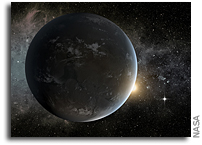Using Dimers to Measure Biosignatures and Atmospheric Pressure for Terrestrial Exoplanets

We present a new method to probe atmospheric pressure on Earthlike planets using (O2-O2) dimers in the near-infrared.
We also show that dimer features could be the most readily detectable biosignatures for Earthlike atmospheres, and may even be detectable in transit transmission with the James Webb Space Telescope (JWST). The absorption by dimers changes more rapidly with pressure and density than that of monomers, and can therefore provide additional information about atmospheric pressures. By comparing the absorption strengths of rotational and vibrational features to the absorption strengths of dimer features, we show that in some cases it may be possible to estimate the pressure at the reflecting surface of a planet.
This method is demonstrated by using the O2 A band and the 1.06 μ m dimer feature, either in transmission or reflected spectra. It works best for planets around M dwarfs with atmospheric pressures between 0.1 and 10 bars, and for O2 volume mixing ratios above 50% of Earth’s present day level. Furthermore, unlike observations of Rayleigh scattering, this method can be used at wavelengths longer than 0.6 μ m, and is therefore potentially applicable, although challenging, to near-term planet characterization missions such as JWST.
We have also performed detectability studies for JWST transit transmission spectroscopy and find that the 1.06 μ m and 1.27 μ m dimer features could be detectable (SNR > 3) for an Earth-analog orbiting an M5V star at a distance of 5 pc. The detection of these features could provide a constraint on the atmospheric pressure of an exoplanet, and serve as biosignatures for oxygenic photosynthesis. We have calculated the required signal-to-noise ratios (SNRs) to detect and characterize O2 monomer and dimer features in reflected spectra and find that SNRs greater than 10 at a spectral resolving power of R=100 would be required.
Amit Misra, Victoria Meadows, Mark Claire, Dave Crisp (Submitted on 6 Dec 2013)
Comments: 39 pages, 24 figures and 2 tables. Accepted for publication in Astrobiology, Dec 2013
Subjects: Earth and Planetary Astrophysics (astro-ph.EP)
Cite as: arXiv:1312.2025 [astro-ph.EP] (or arXiv:1312.2025v1 [astro-ph.EP] for this version)
Submission history From: Amit Misra [v1] Fri, 6 Dec 2013 22:01:52 GMT (432kb)








